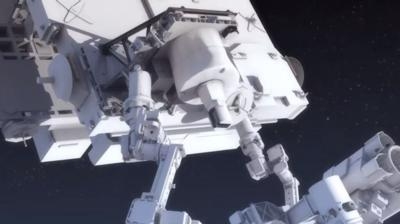SAGE In Final Preparations For Trip To ISS Next Year
A NASA instrument to monitor aerosols, the ozone layer, and other gases in our atmosphere from space arrived Friday, Nov. 20 at NASA's Kennedy Space Center in Florida. The instrument will now begin final preparations for launch to the International Space Station.

The Stratospheric Aerosol and Gas Experiment III on the International Space Station, or SAGE III on ISS, was shipped to Florida from NASA's Langley Research Center in Hampton, Virginia. The SAGE III instrument, developed at NASA Langley, will undergo final tests before being stowed aboard a SpaceX Falcon 9 rocket as part of a NASA space station SpaceX resupply mission. That mission will be launched from Florida's Cape Canaveral Air Force Station no earlier than June 2016.
"It's an important time to add this SAGE III Earth observing instrument for studying atmospheric gases from orbit," said Mike Cisewski, SAGE III on ISS project manager. "The SAGE III data will help scientists get a better idea of the state of recovery in the ozone layer along with other key aerosol measurements that will provide further insight into the trends and processes influencing global climate change."
The SAGE III instrument will be used primarily to study ozone, a gas found in the upper atmosphere that acts as Earth's sunscreen by blocking much of the Sun's harmful ultraviolet radiation. More than 30 years ago, scientists discovered that our planet's protective coat of ozone was thinning. Since then, NASA has orbited a series of increasingly sophisticated SAGE instruments to make accurate measurements of ozone amounts in the upper atmosphere.
In 1975, the Stratospheric Aerosol Measurement on-orbit experiment was conducted as part of the Apollo-Soyuz Test Project. The SAGE II instrument was launched aboard NASA's Earth Radiation Budget Satellite in October 1984 and collected measurements of stratospheric ozone until 2005. A NASA-supplied SAGE III instrument was launched on the Russian Meteor-3M spacecraft in December 2001 and ended service in March 2006. SAGE measurements have played a key role in monitoring the ozone recovery resulting from the 1987 Montreal Protocol's internationally mandated policy changes regulating production of chlorine-containing chemicals.
The newest SAGE III Earth-observing instrument will be mounted on a Nadir Viewing Platorm, which was also developed by NASA Langley, shipped to Kennedy Space Center in January 2015, and will be launched along with SAGE III in mid-2016. Once they arrive at the ISS, the Nadir Viewing Platform and SAGE III will be robotically installed on the space station's ExPress Logistics Carrier – an unpressurized payload platform– where SAGE III will operate alongside experiments from other countries.
The SAGE III instrument measures light intensities observed at the space station after passing through the Earth's atmosphere during sunsets, sunrises, moonsets and moonrises. As the ISS goes behind the Earth relative to the sun or moon, the instrument measures the dimming of the sunlight or moonlight caused by the Earth's atmosphere. This dimming, in turn, changes with changing atmospheric aerosol and ozone levels. By making these measurements, SAGE III will provide a long-term data record of key components of the Earth's atmosphere vital for improved understanding of climate change and ozone chemistry.
SAGE III on ISS is a partnership between NASA Langley and the International Space Station Program Office at NASA's Johnson Space Center in Houston, with support from the Earth Science Division of NASA's Science Mission Directorate in Washington. Other mission partners include the Kennedy Space Center, Ball Aerospace Technologies Corp., the European Space Agency, Thales Alenia Space-Italy, NASA's Goddard Space Flight Center in Greenbelt, Maryland; NASA's Marshall Space Flight Center in Huntsville, Alabama; SpaceX; and Hampton University in Hampton, Virginia.
(Source: NASA news release. Image from NASA animation)
 ANN's Daily Aero-Term (04.20.24): Light Gun
ANN's Daily Aero-Term (04.20.24): Light Gun Aero-News: Quote of the Day (04.20.24)
Aero-News: Quote of the Day (04.20.24) ANN's Daily Aero-Linx (04.21.24)
ANN's Daily Aero-Linx (04.21.24) Aero-News: Quote of the Day (04.21.24)
Aero-News: Quote of the Day (04.21.24) ANN's Daily Aero-Term (04.21.24): Aircraft Conflict
ANN's Daily Aero-Term (04.21.24): Aircraft Conflict



